Project Management Individual Assessment: DAM798, Level 7, Semester 1
VerifiedAdded on 2022/09/26
|18
|3026
|16
Project
AI Summary
This project management assignment, completed for a Graduate Diploma in Applied Management (DAM798), comprehensively addresses key project management concepts. The assignment begins with the creation of a network diagram and the calculation of critical path elements such as EST, LST, EFT, and LFT. It then delves into cost estimation techniques, comparing bottom-up and top-down approaches and analyzing their advantages and disadvantages. The assignment also includes a detailed examination of the project budgeting process, encompassing contingency and management reserves, alongside an application of Earned Value Management (EVM) techniques, calculating PV, EV, CV, SV, CPI, SPI, EAC, VAC, and ETC. Furthermore, the document provides a vendor selection analysis and a thorough risk management plan, including risk identification, categorization, and mitigation strategies. Finally, the assignment evaluates project management software tools, discussing their capabilities and limitations. The assignment demonstrates a strong understanding of project management principles and their practical application.
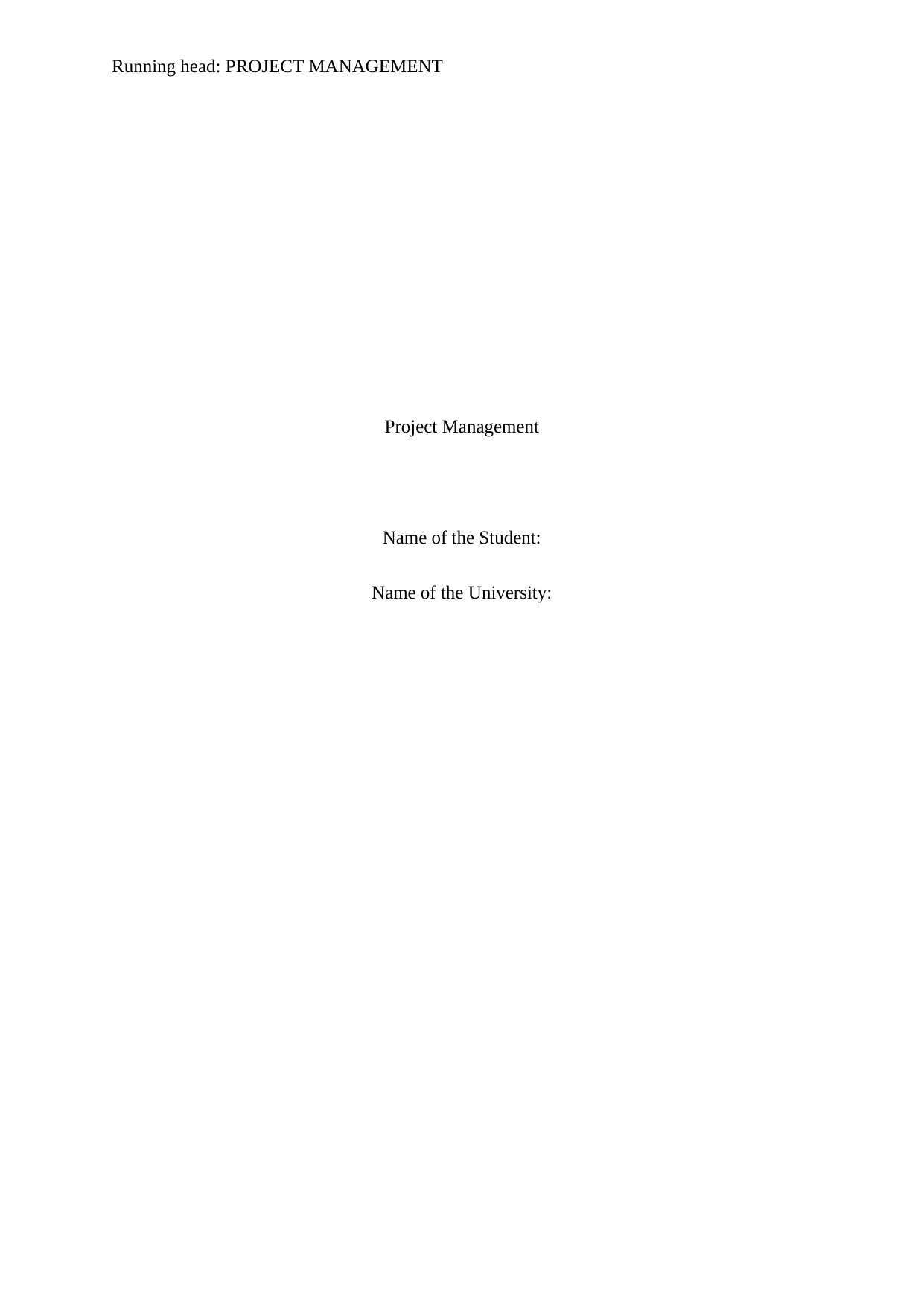
Running head: PROJECT MANAGEMENT
Project Management
Name of the Student:
Name of the University:
Project Management
Name of the Student:
Name of the University:
Paraphrase This Document
Need a fresh take? Get an instant paraphrase of this document with our AI Paraphraser
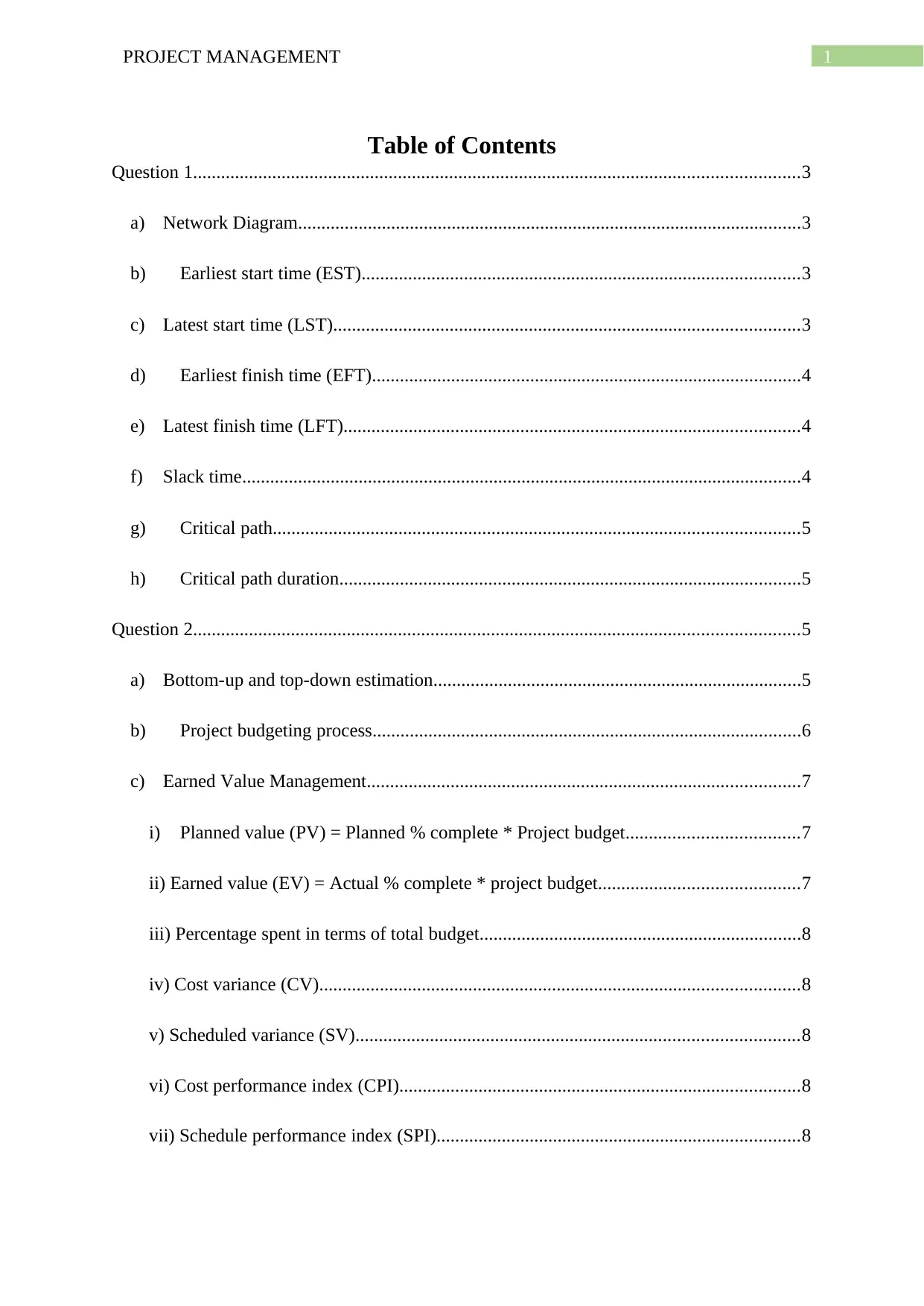
1PROJECT MANAGEMENT
Table of Contents
Question 1..................................................................................................................................3
a) Network Diagram............................................................................................................3
b) Earliest start time (EST)..............................................................................................3
c) Latest start time (LST)....................................................................................................3
d) Earliest finish time (EFT)............................................................................................4
e) Latest finish time (LFT)..................................................................................................4
f) Slack time........................................................................................................................4
g) Critical path.................................................................................................................5
h) Critical path duration...................................................................................................5
Question 2..................................................................................................................................5
a) Bottom-up and top-down estimation...............................................................................5
b) Project budgeting process............................................................................................6
c) Earned Value Management.............................................................................................7
i) Planned value (PV) = Planned % complete * Project budget.....................................7
ii) Earned value (EV) = Actual % complete * project budget...........................................7
iii) Percentage spent in terms of total budget.....................................................................8
iv) Cost variance (CV).......................................................................................................8
v) Scheduled variance (SV)...............................................................................................8
vi) Cost performance index (CPI)......................................................................................8
vii) Schedule performance index (SPI)..............................................................................8
Table of Contents
Question 1..................................................................................................................................3
a) Network Diagram............................................................................................................3
b) Earliest start time (EST)..............................................................................................3
c) Latest start time (LST)....................................................................................................3
d) Earliest finish time (EFT)............................................................................................4
e) Latest finish time (LFT)..................................................................................................4
f) Slack time........................................................................................................................4
g) Critical path.................................................................................................................5
h) Critical path duration...................................................................................................5
Question 2..................................................................................................................................5
a) Bottom-up and top-down estimation...............................................................................5
b) Project budgeting process............................................................................................6
c) Earned Value Management.............................................................................................7
i) Planned value (PV) = Planned % complete * Project budget.....................................7
ii) Earned value (EV) = Actual % complete * project budget...........................................7
iii) Percentage spent in terms of total budget.....................................................................8
iv) Cost variance (CV).......................................................................................................8
v) Scheduled variance (SV)...............................................................................................8
vi) Cost performance index (CPI)......................................................................................8
vii) Schedule performance index (SPI)..............................................................................8
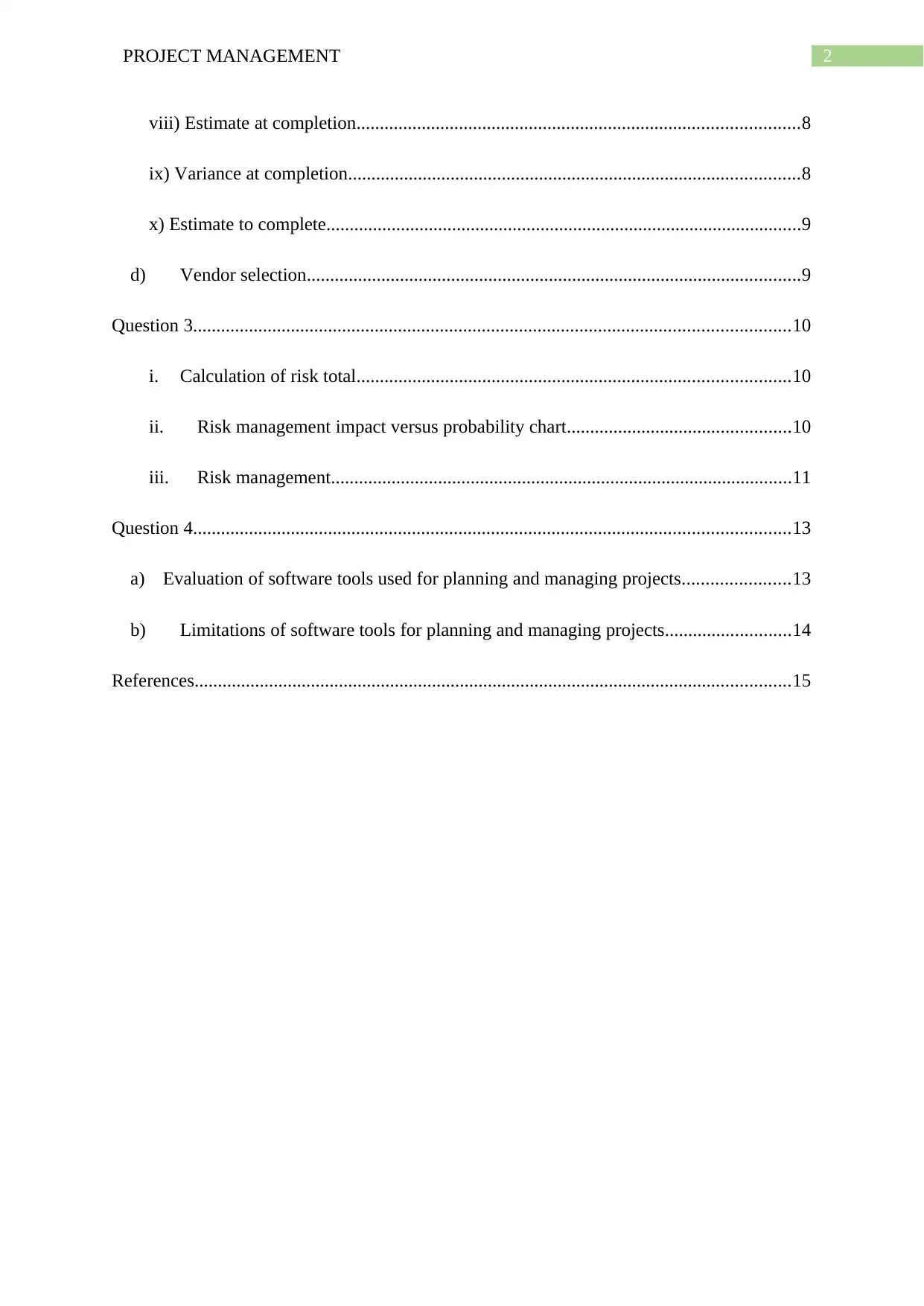
2PROJECT MANAGEMENT
viii) Estimate at completion...............................................................................................8
ix) Variance at completion.................................................................................................8
x) Estimate to complete......................................................................................................9
d) Vendor selection..........................................................................................................9
Question 3................................................................................................................................10
i. Calculation of risk total.............................................................................................10
ii. Risk management impact versus probability chart................................................10
iii. Risk management...................................................................................................11
Question 4................................................................................................................................13
a) Evaluation of software tools used for planning and managing projects.......................13
b) Limitations of software tools for planning and managing projects...........................14
References................................................................................................................................15
viii) Estimate at completion...............................................................................................8
ix) Variance at completion.................................................................................................8
x) Estimate to complete......................................................................................................9
d) Vendor selection..........................................................................................................9
Question 3................................................................................................................................10
i. Calculation of risk total.............................................................................................10
ii. Risk management impact versus probability chart................................................10
iii. Risk management...................................................................................................11
Question 4................................................................................................................................13
a) Evaluation of software tools used for planning and managing projects.......................13
b) Limitations of software tools for planning and managing projects...........................14
References................................................................................................................................15
⊘ This is a preview!⊘
Do you want full access?
Subscribe today to unlock all pages.

Trusted by 1+ million students worldwide

3PROJECT MANAGEMENT
Question 1
a) Network Diagram
Figure 1: Task Network Diagram
(Source: Created by author)
b) Earliest start time (EST)
Activit
y Time EST
(weeks)
A 4 0
B 8 0
C 6 8
D 10 14
E 8 14
F 6 24
G 7 24
H 5 31
c) Latest start time (LST)
Activit
y Time LST
(weeks)
A 4 4
B 8 0
C 6 8
Question 1
a) Network Diagram
Figure 1: Task Network Diagram
(Source: Created by author)
b) Earliest start time (EST)
Activit
y Time EST
(weeks)
A 4 0
B 8 0
C 6 8
D 10 14
E 8 14
F 6 24
G 7 24
H 5 31
c) Latest start time (LST)
Activit
y Time LST
(weeks)
A 4 4
B 8 0
C 6 8
Paraphrase This Document
Need a fresh take? Get an instant paraphrase of this document with our AI Paraphraser
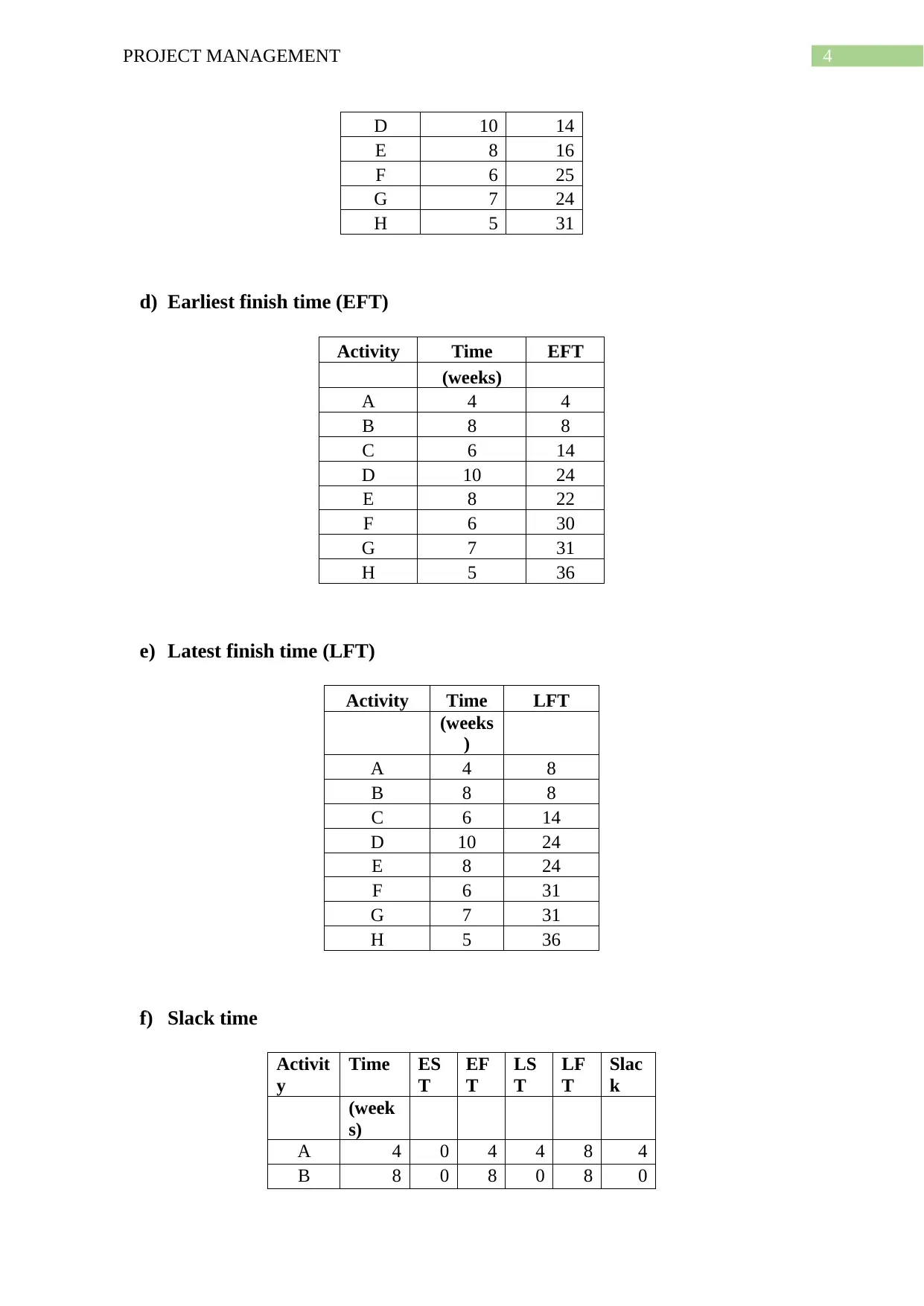
4PROJECT MANAGEMENT
D 10 14
E 8 16
F 6 25
G 7 24
H 5 31
d) Earliest finish time (EFT)
Activity Time EFT
(weeks)
A 4 4
B 8 8
C 6 14
D 10 24
E 8 22
F 6 30
G 7 31
H 5 36
e) Latest finish time (LFT)
Activity Time LFT
(weeks
)
A 4 8
B 8 8
C 6 14
D 10 24
E 8 24
F 6 31
G 7 31
H 5 36
f) Slack time
Activit
y
Time ES
T
EF
T
LS
T
LF
T
Slac
k
(week
s)
A 4 0 4 4 8 4
B 8 0 8 0 8 0
D 10 14
E 8 16
F 6 25
G 7 24
H 5 31
d) Earliest finish time (EFT)
Activity Time EFT
(weeks)
A 4 4
B 8 8
C 6 14
D 10 24
E 8 22
F 6 30
G 7 31
H 5 36
e) Latest finish time (LFT)
Activity Time LFT
(weeks
)
A 4 8
B 8 8
C 6 14
D 10 24
E 8 24
F 6 31
G 7 31
H 5 36
f) Slack time
Activit
y
Time ES
T
EF
T
LS
T
LF
T
Slac
k
(week
s)
A 4 0 4 4 8 4
B 8 0 8 0 8 0
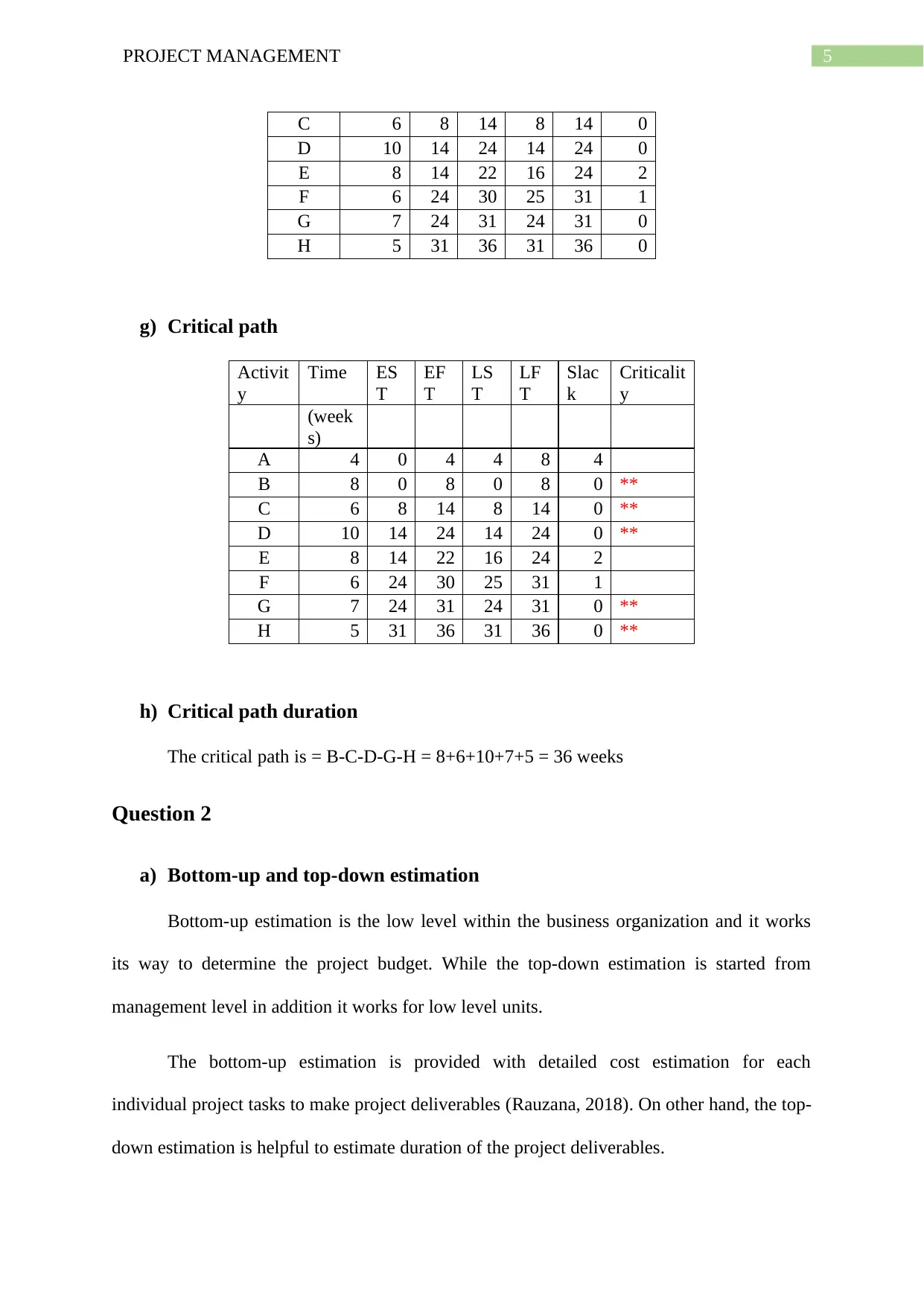
5PROJECT MANAGEMENT
C 6 8 14 8 14 0
D 10 14 24 14 24 0
E 8 14 22 16 24 2
F 6 24 30 25 31 1
G 7 24 31 24 31 0
H 5 31 36 31 36 0
g) Critical path
Activit
y
Time ES
T
EF
T
LS
T
LF
T
Slac
k
Criticalit
y
(week
s)
A 4 0 4 4 8 4
B 8 0 8 0 8 0 **
C 6 8 14 8 14 0 **
D 10 14 24 14 24 0 **
E 8 14 22 16 24 2
F 6 24 30 25 31 1
G 7 24 31 24 31 0 **
H 5 31 36 31 36 0 **
h) Critical path duration
The critical path is = B-C-D-G-H = 8+6+10+7+5 = 36 weeks
Question 2
a) Bottom-up and top-down estimation
Bottom-up estimation is the low level within the business organization and it works
its way to determine the project budget. While the top-down estimation is started from
management level in addition it works for low level units.
The bottom-up estimation is provided with detailed cost estimation for each
individual project tasks to make project deliverables (Rauzana, 2018). On other hand, the top-
down estimation is helpful to estimate duration of the project deliverables.
C 6 8 14 8 14 0
D 10 14 24 14 24 0
E 8 14 22 16 24 2
F 6 24 30 25 31 1
G 7 24 31 24 31 0
H 5 31 36 31 36 0
g) Critical path
Activit
y
Time ES
T
EF
T
LS
T
LF
T
Slac
k
Criticalit
y
(week
s)
A 4 0 4 4 8 4
B 8 0 8 0 8 0 **
C 6 8 14 8 14 0 **
D 10 14 24 14 24 0 **
E 8 14 22 16 24 2
F 6 24 30 25 31 1
G 7 24 31 24 31 0 **
H 5 31 36 31 36 0 **
h) Critical path duration
The critical path is = B-C-D-G-H = 8+6+10+7+5 = 36 weeks
Question 2
a) Bottom-up and top-down estimation
Bottom-up estimation is the low level within the business organization and it works
its way to determine the project budget. While the top-down estimation is started from
management level in addition it works for low level units.
The bottom-up estimation is provided with detailed cost estimation for each
individual project tasks to make project deliverables (Rauzana, 2018). On other hand, the top-
down estimation is helpful to estimate duration of the project deliverables.
⊘ This is a preview!⊘
Do you want full access?
Subscribe today to unlock all pages.

Trusted by 1+ million students worldwide
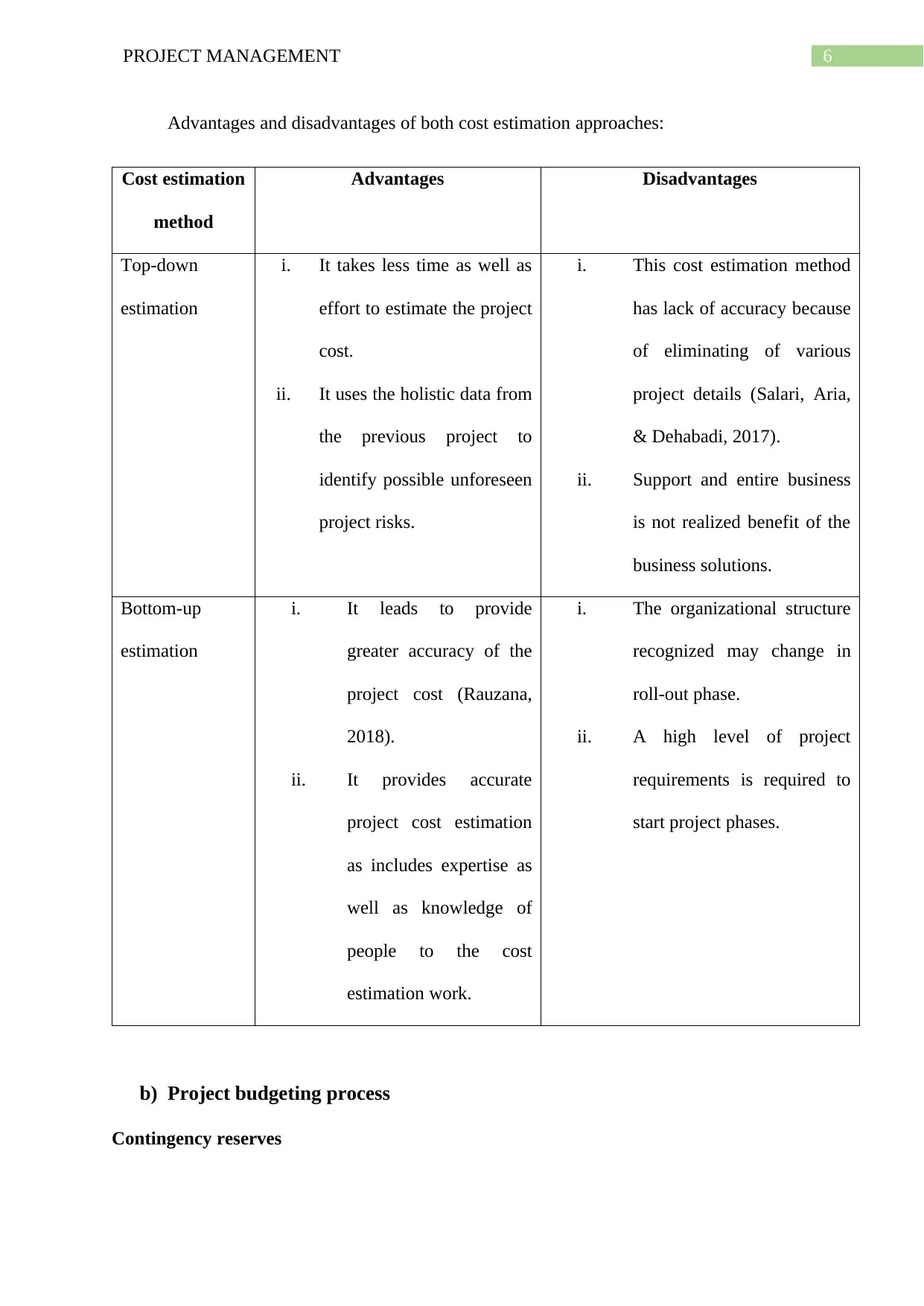
6PROJECT MANAGEMENT
Advantages and disadvantages of both cost estimation approaches:
Cost estimation
method
Advantages Disadvantages
Top-down
estimation
i. It takes less time as well as
effort to estimate the project
cost.
ii. It uses the holistic data from
the previous project to
identify possible unforeseen
project risks.
i. This cost estimation method
has lack of accuracy because
of eliminating of various
project details (Salari, Aria,
& Dehabadi, 2017).
ii. Support and entire business
is not realized benefit of the
business solutions.
Bottom-up
estimation
i. It leads to provide
greater accuracy of the
project cost (Rauzana,
2018).
ii. It provides accurate
project cost estimation
as includes expertise as
well as knowledge of
people to the cost
estimation work.
i. The organizational structure
recognized may change in
roll-out phase.
ii. A high level of project
requirements is required to
start project phases.
b) Project budgeting process
Contingency reserves
Advantages and disadvantages of both cost estimation approaches:
Cost estimation
method
Advantages Disadvantages
Top-down
estimation
i. It takes less time as well as
effort to estimate the project
cost.
ii. It uses the holistic data from
the previous project to
identify possible unforeseen
project risks.
i. This cost estimation method
has lack of accuracy because
of eliminating of various
project details (Salari, Aria,
& Dehabadi, 2017).
ii. Support and entire business
is not realized benefit of the
business solutions.
Bottom-up
estimation
i. It leads to provide
greater accuracy of the
project cost (Rauzana,
2018).
ii. It provides accurate
project cost estimation
as includes expertise as
well as knowledge of
people to the cost
estimation work.
i. The organizational structure
recognized may change in
roll-out phase.
ii. A high level of project
requirements is required to
start project phases.
b) Project budgeting process
Contingency reserves
Paraphrase This Document
Need a fresh take? Get an instant paraphrase of this document with our AI Paraphraser
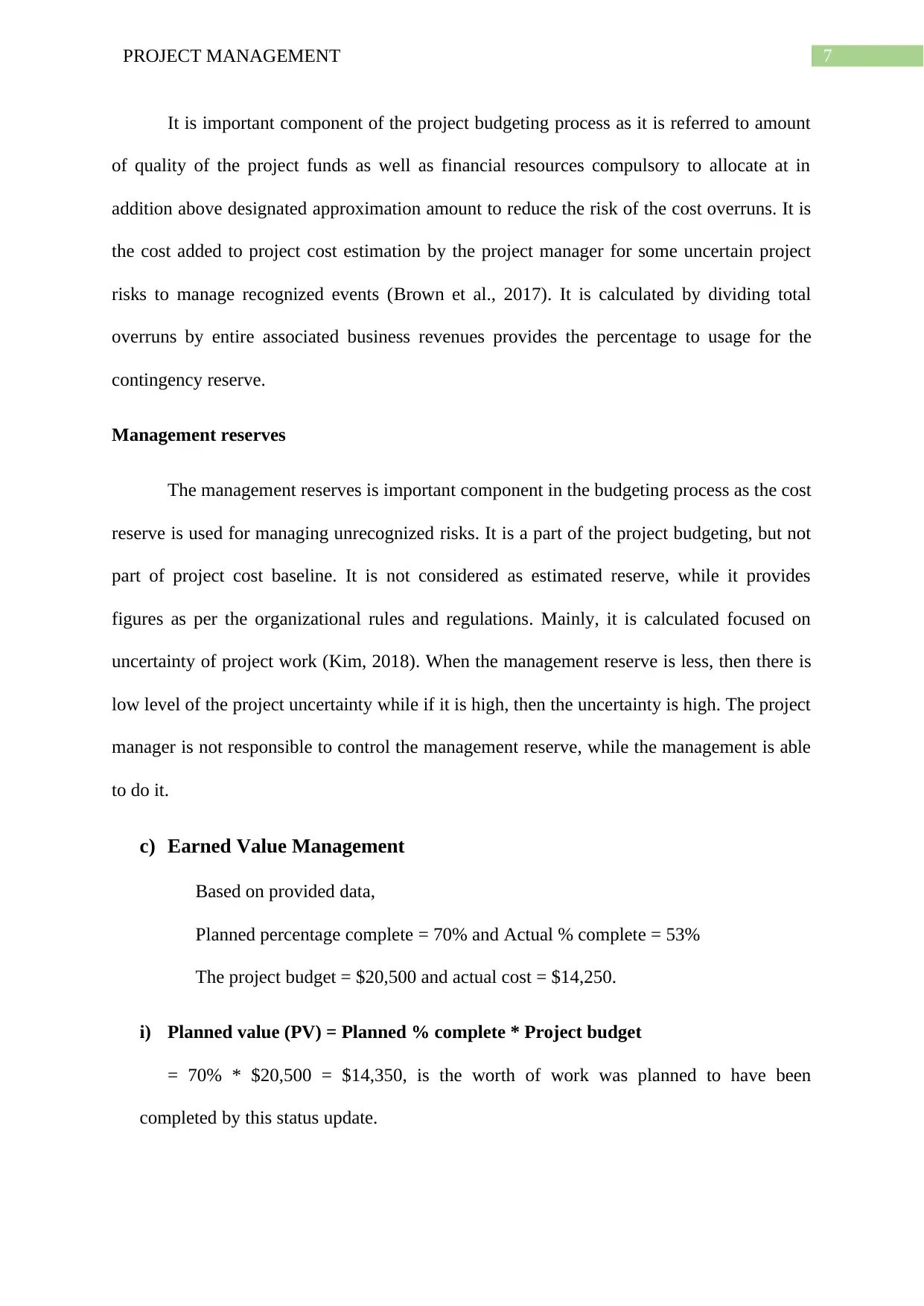
7PROJECT MANAGEMENT
It is important component of the project budgeting process as it is referred to amount
of quality of the project funds as well as financial resources compulsory to allocate at in
addition above designated approximation amount to reduce the risk of the cost overruns. It is
the cost added to project cost estimation by the project manager for some uncertain project
risks to manage recognized events (Brown et al., 2017). It is calculated by dividing total
overruns by entire associated business revenues provides the percentage to usage for the
contingency reserve.
Management reserves
The management reserves is important component in the budgeting process as the cost
reserve is used for managing unrecognized risks. It is a part of the project budgeting, but not
part of project cost baseline. It is not considered as estimated reserve, while it provides
figures as per the organizational rules and regulations. Mainly, it is calculated focused on
uncertainty of project work (Kim, 2018). When the management reserve is less, then there is
low level of the project uncertainty while if it is high, then the uncertainty is high. The project
manager is not responsible to control the management reserve, while the management is able
to do it.
c) Earned Value Management
Based on provided data,
Planned percentage complete = 70% and Actual % complete = 53%
The project budget = $20,500 and actual cost = $14,250.
i) Planned value (PV) = Planned % complete * Project budget
= 70% * $20,500 = $14,350, is the worth of work was planned to have been
completed by this status update.
It is important component of the project budgeting process as it is referred to amount
of quality of the project funds as well as financial resources compulsory to allocate at in
addition above designated approximation amount to reduce the risk of the cost overruns. It is
the cost added to project cost estimation by the project manager for some uncertain project
risks to manage recognized events (Brown et al., 2017). It is calculated by dividing total
overruns by entire associated business revenues provides the percentage to usage for the
contingency reserve.
Management reserves
The management reserves is important component in the budgeting process as the cost
reserve is used for managing unrecognized risks. It is a part of the project budgeting, but not
part of project cost baseline. It is not considered as estimated reserve, while it provides
figures as per the organizational rules and regulations. Mainly, it is calculated focused on
uncertainty of project work (Kim, 2018). When the management reserve is less, then there is
low level of the project uncertainty while if it is high, then the uncertainty is high. The project
manager is not responsible to control the management reserve, while the management is able
to do it.
c) Earned Value Management
Based on provided data,
Planned percentage complete = 70% and Actual % complete = 53%
The project budget = $20,500 and actual cost = $14,250.
i) Planned value (PV) = Planned % complete * Project budget
= 70% * $20,500 = $14,350, is the worth of work was planned to have been
completed by this status update.
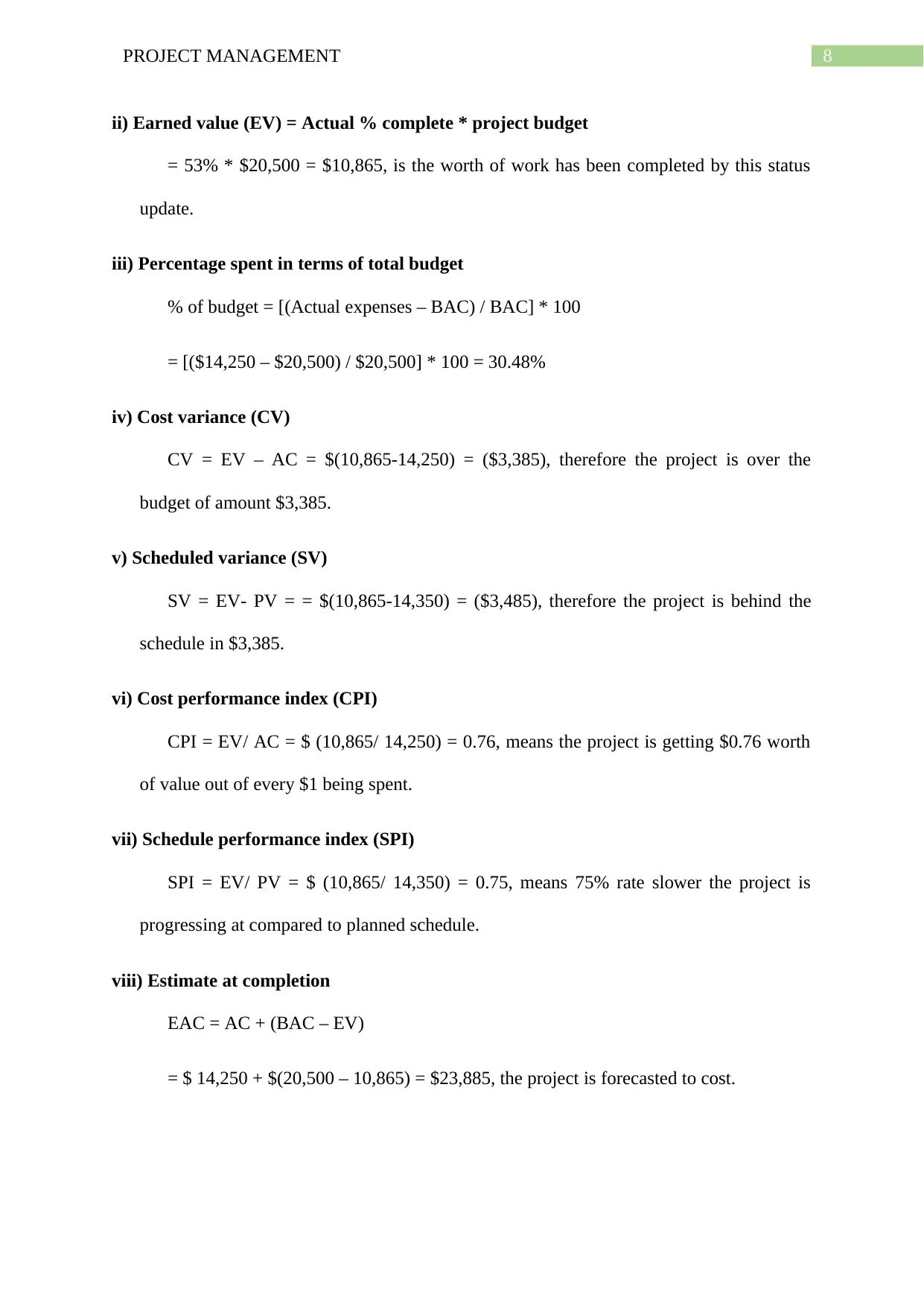
8PROJECT MANAGEMENT
ii) Earned value (EV) = Actual % complete * project budget
= 53% * $20,500 = $10,865, is the worth of work has been completed by this status
update.
iii) Percentage spent in terms of total budget
% of budget = [(Actual expenses – BAC) / BAC] * 100
= [($14,250 – $20,500) / $20,500] * 100 = 30.48%
iv) Cost variance (CV)
CV = EV – AC = $(10,865-14,250) = ($3,385), therefore the project is over the
budget of amount $3,385.
v) Scheduled variance (SV)
SV = EV- PV = = $(10,865-14,350) = ($3,485), therefore the project is behind the
schedule in $3,385.
vi) Cost performance index (CPI)
CPI = EV/ AC = $ (10,865/ 14,250) = 0.76, means the project is getting $0.76 worth
of value out of every $1 being spent.
vii) Schedule performance index (SPI)
SPI = EV/ PV = $ (10,865/ 14,350) = 0.75, means 75% rate slower the project is
progressing at compared to planned schedule.
viii) Estimate at completion
EAC = AC + (BAC – EV)
= $ 14,250 + $(20,500 – 10,865) = $23,885, the project is forecasted to cost.
ii) Earned value (EV) = Actual % complete * project budget
= 53% * $20,500 = $10,865, is the worth of work has been completed by this status
update.
iii) Percentage spent in terms of total budget
% of budget = [(Actual expenses – BAC) / BAC] * 100
= [($14,250 – $20,500) / $20,500] * 100 = 30.48%
iv) Cost variance (CV)
CV = EV – AC = $(10,865-14,250) = ($3,385), therefore the project is over the
budget of amount $3,385.
v) Scheduled variance (SV)
SV = EV- PV = = $(10,865-14,350) = ($3,485), therefore the project is behind the
schedule in $3,385.
vi) Cost performance index (CPI)
CPI = EV/ AC = $ (10,865/ 14,250) = 0.76, means the project is getting $0.76 worth
of value out of every $1 being spent.
vii) Schedule performance index (SPI)
SPI = EV/ PV = $ (10,865/ 14,350) = 0.75, means 75% rate slower the project is
progressing at compared to planned schedule.
viii) Estimate at completion
EAC = AC + (BAC – EV)
= $ 14,250 + $(20,500 – 10,865) = $23,885, the project is forecasted to cost.
⊘ This is a preview!⊘
Do you want full access?
Subscribe today to unlock all pages.

Trusted by 1+ million students worldwide

9PROJECT MANAGEMENT
ix) Variance at completion
VAC = BAC – EAC = $ (20,500 – 23,885) = ($3,385), the project is forecasted to be
over budget in $3,385.
x) Estimate to complete
ETC = (BAC – EV) / CPI = $(20,500 – 10,865) / 0.76 = $12,677.63, means the
estimated forecasted cost $23,885 to complete the project in $12,677.63.
d) Vendor selection
Based on the categorical analysis, Omnicron Ltd is required to select three vendors for
their procurement as well as delivery of the main project in supply chain project. As per my
point of view, this method is not suitable to select the vendor.
Constructing a weighted matrix is suitable for selection of the project vendor. The
vendor selection criteria are price, superiority, distribution, facility, social responsibility,
suitability, risk and agility (Dutta, Gwebu, & Wang, 2017). This method is not required for
weighting of each criteria and it is used as tool for exchanging with incompetent project
suppliers. It requires qualitative pairwise comparisons among the vendor selection criteria.
Disadvantages are that it does not support final selection of the vendor. There is a
strict proportion between the number of criteria for selection as well as number of the project
vendors (Duxbury & Haynie, 2018). This method is only limited to the quantitative criteria
for vendor selection.
ix) Variance at completion
VAC = BAC – EAC = $ (20,500 – 23,885) = ($3,385), the project is forecasted to be
over budget in $3,385.
x) Estimate to complete
ETC = (BAC – EV) / CPI = $(20,500 – 10,865) / 0.76 = $12,677.63, means the
estimated forecasted cost $23,885 to complete the project in $12,677.63.
d) Vendor selection
Based on the categorical analysis, Omnicron Ltd is required to select three vendors for
their procurement as well as delivery of the main project in supply chain project. As per my
point of view, this method is not suitable to select the vendor.
Constructing a weighted matrix is suitable for selection of the project vendor. The
vendor selection criteria are price, superiority, distribution, facility, social responsibility,
suitability, risk and agility (Dutta, Gwebu, & Wang, 2017). This method is not required for
weighting of each criteria and it is used as tool for exchanging with incompetent project
suppliers. It requires qualitative pairwise comparisons among the vendor selection criteria.
Disadvantages are that it does not support final selection of the vendor. There is a
strict proportion between the number of criteria for selection as well as number of the project
vendors (Duxbury & Haynie, 2018). This method is only limited to the quantitative criteria
for vendor selection.
Paraphrase This Document
Need a fresh take? Get an instant paraphrase of this document with our AI Paraphraser
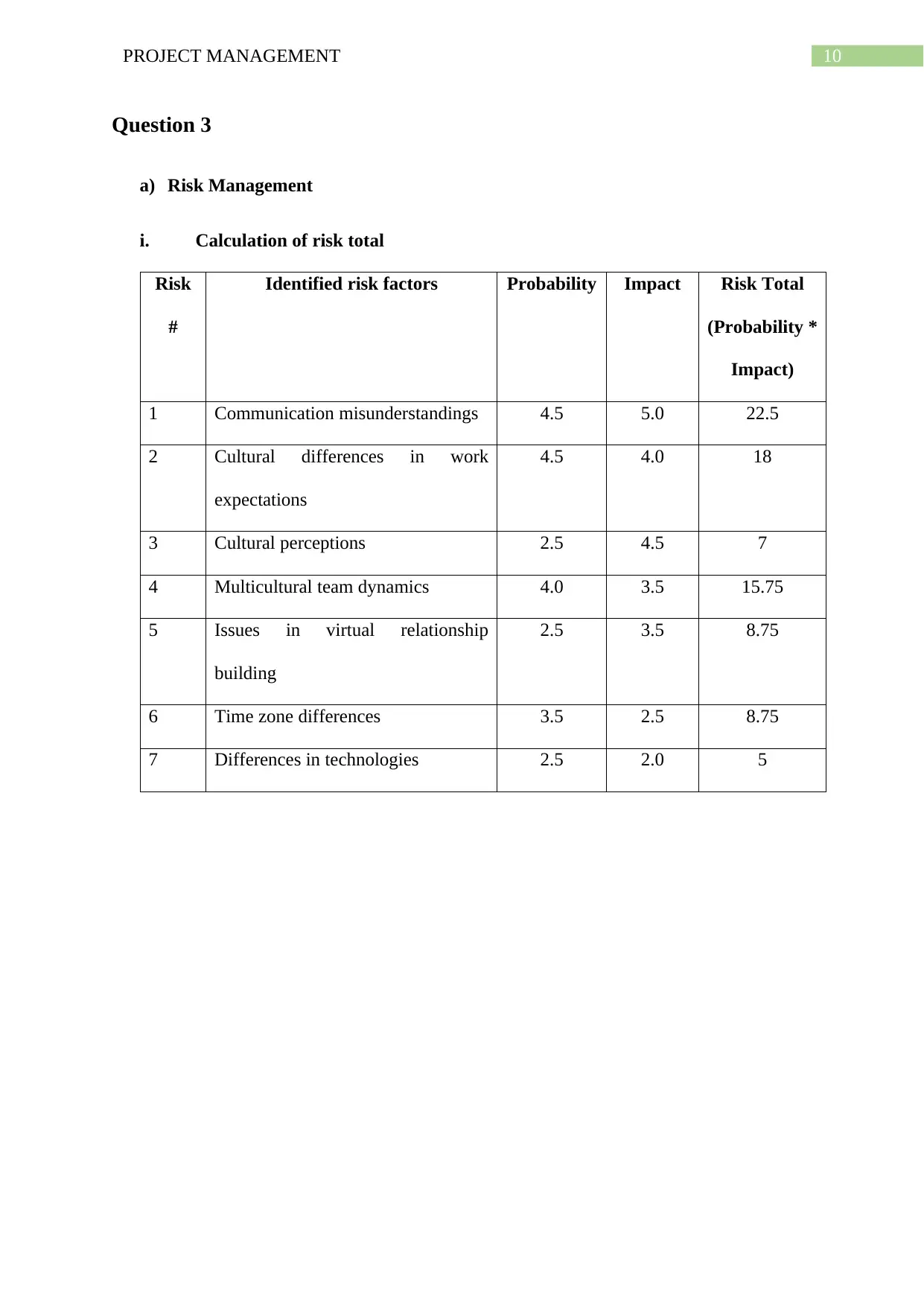
10PROJECT MANAGEMENT
Question 3
a) Risk Management
i. Calculation of risk total
Risk
#
Identified risk factors Probability Impact Risk Total
(Probability *
Impact)
1 Communication misunderstandings 4.5 5.0 22.5
2 Cultural differences in work
expectations
4.5 4.0 18
3 Cultural perceptions 2.5 4.5 7
4 Multicultural team dynamics 4.0 3.5 15.75
5 Issues in virtual relationship
building
2.5 3.5 8.75
6 Time zone differences 3.5 2.5 8.75
7 Differences in technologies 2.5 2.0 5
Question 3
a) Risk Management
i. Calculation of risk total
Risk
#
Identified risk factors Probability Impact Risk Total
(Probability *
Impact)
1 Communication misunderstandings 4.5 5.0 22.5
2 Cultural differences in work
expectations
4.5 4.0 18
3 Cultural perceptions 2.5 4.5 7
4 Multicultural team dynamics 4.0 3.5 15.75
5 Issues in virtual relationship
building
2.5 3.5 8.75
6 Time zone differences 3.5 2.5 8.75
7 Differences in technologies 2.5 2.0 5
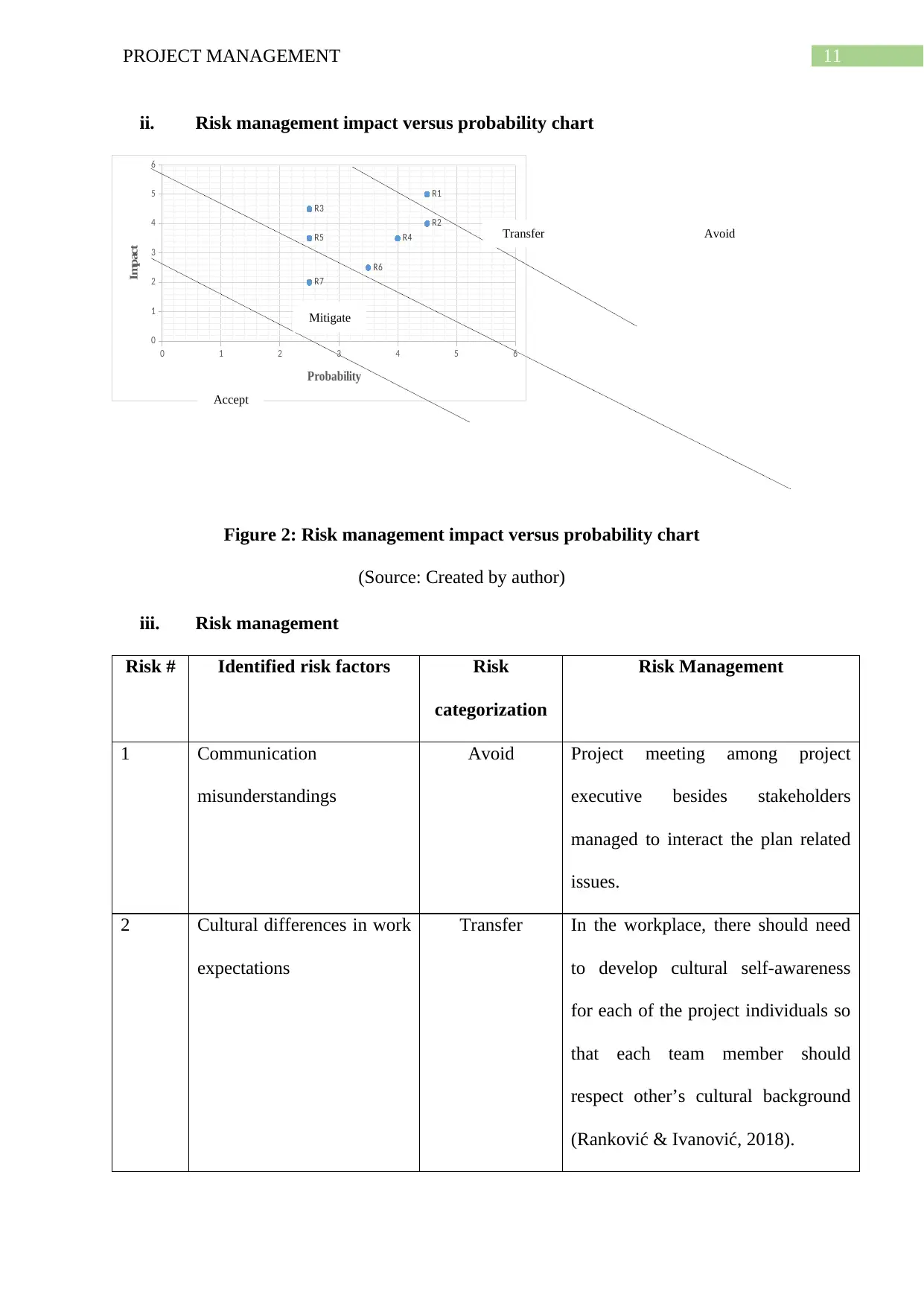
11PROJECT MANAGEMENT
ii. Risk management impact versus probability chart
0 1 2 3 4 5 6
0
1
2
3
4
5
6
R1
R2
R3
R4R5
R6
R7
Probability
Impact
Figure 2: Risk management impact versus probability chart
(Source: Created by author)
iii. Risk management
Risk # Identified risk factors Risk
categorization
Risk Management
1 Communication
misunderstandings
Avoid Project meeting among project
executive besides stakeholders
managed to interact the plan related
issues.
2 Cultural differences in work
expectations
Transfer In the workplace, there should need
to develop cultural self-awareness
for each of the project individuals so
that each team member should
respect other’s cultural background
(Ranković & Ivanović, 2018).
Accept
Mitigate
Transfer Avoid
ii. Risk management impact versus probability chart
0 1 2 3 4 5 6
0
1
2
3
4
5
6
R1
R2
R3
R4R5
R6
R7
Probability
Impact
Figure 2: Risk management impact versus probability chart
(Source: Created by author)
iii. Risk management
Risk # Identified risk factors Risk
categorization
Risk Management
1 Communication
misunderstandings
Avoid Project meeting among project
executive besides stakeholders
managed to interact the plan related
issues.
2 Cultural differences in work
expectations
Transfer In the workplace, there should need
to develop cultural self-awareness
for each of the project individuals so
that each team member should
respect other’s cultural background
(Ranković & Ivanović, 2018).
Accept
Mitigate
Transfer Avoid
⊘ This is a preview!⊘
Do you want full access?
Subscribe today to unlock all pages.

Trusted by 1+ million students worldwide
1 out of 18
Related Documents
Your All-in-One AI-Powered Toolkit for Academic Success.
+13062052269
info@desklib.com
Available 24*7 on WhatsApp / Email
![[object Object]](/_next/static/media/star-bottom.7253800d.svg)
Unlock your academic potential
Copyright © 2020–2025 A2Z Services. All Rights Reserved. Developed and managed by ZUCOL.



